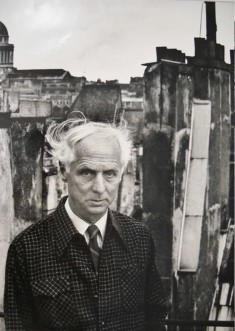| Max Ernst | |
|---|---|
 |
|
| Born | Apr. 2, 1891 Bruhl, Germany |
| Died | Apr. 1, 1976 (at age 84) Paris, France |
| Nationality | German |
| Education | University of Bonn |
| Movement | Dadaism, Surrealism |
| Field | Painting, Sculpting |
| Works | |
Max Ernst was a German artist largely known for his contribution to the avant-garde movements of Dadaism and Surrealism. His unusual techniques and strange combinations of images have left their mark on the world of abstract art for generations of artists after him.
Ernst’s Early Years
Born into a large Catholic family in 1891, Max Ernst was influenced by the world of art very early in his life. His father was a self-taught painter and a teacher. His father’s love for painting the outdoors rubbed off on Max and it encouraged him to begin sketching and painting.
In 1909, he began his collegiate studies at the University of Bonn, studying a variety of subjects. After visiting mental institutions for his psychiatry and psychology courses, he became very interested in the paintings of the patients. The following year, his fascination with art became reality when he began to hone in on his skills. In 1911 he befriended fellow artists and decided that art would become his profession.
Ernst’s early visits to exhibitions by famous artists like Picasso, Van Gogh, and Gauguin helped to shape how he was to begin his own career. By 1913, he had shown his own works in several exhibitions in Cologne, Germany.
Ernst and World War I
Max Ernst’s life took a drastic turn when in 1914 he was drafted to fight in World War I. Serving on the Western and Eastern fronts, Ernst was given the task of designing charts and maps. This enabled him to continue his artwork and influenced him to use his art to give a message.
Artistic Movements and Techniques
After his stint in the military, Ernst moved back to Cologne and married Luise Straus. Their marriage was very short, but they did have a son who later became an artist as well. However, Ernst did not stop being inspired.
In 1918, Ernst, along with other artists, formed the Dada Movement. This movement was inspired by the frustrations many felt about the war. Its unconventional forms and unusual mediums defined an early 20th century Europe of the time. Ernst began creating collages using a lithograph technique. In addition, Ernst published the magazine Der Strom and exhibited his works that illustrated the Dada style.
Ernst had his first exhibition in Paris, France, in 1921. His strange imagery constructed his collages and paintings and made his work quite fascinating to observers. His painting Celebes and Dadaville illustrated this by having a myriad of visions combined with solid hues.
A year later, a budding friendship with Breton and Eluard piqued Ernst’s interest in the Surrealist Movement. He began playing with the frottage, or rubbing technique, and produced several paintings and illustrations that used imaginary creatures and photographic precision. Ernst also published a collection of collage novels. In 1929, La Femme 100 tetes was published. In 1930, he worked side-by-side with Salvador Dali creating works of art.
Ernst’s American Debut
Max Ernst did not make an American debut until 1932. The Julien Levy Gallery in New York was the first gallery in the United States to exhibit his work. A few years later, his work was presented at the Museum of Modern Art in New York City. The exhibition was a display of the history of the Dada Movement and its transition into the Surrealist Movement. Ernst also began to explore the world of sculpting and his work was collected by many wealthy supporters of the art community.
World War II and Later Life
The start of World War II in 1939 put Ernst and a few of his artist friends on an enemy list. Their outspoken views on the war and their artwork made them a prime target. After several arrests, Ernst was able to flee to the United States with the help of Peggy Guggenheim. The two were later married in 1941.
His time fleeing from the war also influenced a new artistic movement in the United States known as the Abstract Expressionism Movement. In this movement, abstract artists use the power of spontaneity to produce unusual pieces of work.
After having a hand in several important artistic movements of the 20th century, Max Ernst settled with his new wife Dorothea Tanning in a tiny town in the south of France. He continued working and producing highly prized pieces of art and literature that are still exhibited in major museums around the world. He died in 1976 in Paris, France.